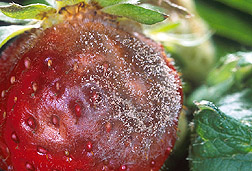This page has been archived and is being provided for reference purposes only. The page is no longer being updated, and therefore, links on the page may be invalid.
|
Read the magazine story to find out more. |
New Insights May Lead to Better Control of Gray MoldBy Kathryn Barry StelljesSeptember 11, 2001 Gray mold (Botrytissp.) reduces yield, softens fruit, or affects color in a wide range of small fruit, grape and nursery crops. In the Pacific Northwest alone, the mold causes up to $125 million per year in crop losses. Agricultural Research Service scientists at the agency’s Horticultural Crops Research Laboratory in Corvallis, Ore., and researchers at Oregon State University in Corvallis, have discovered one previously unknown reason for the mold’s success. They found that the mold can live as an epiphyte. That means mold spores germinate and grow unnoticed on the surface of leaves and other plant parts, drawing nutrients from plant surfaces without damaging the plant. Mold can thus be present constantly until the perfect conditions arise to infect the plant and cause disease. The mold spores can move from leaf hair to leaf hair, allowing the mold to spread quickly and to come into less contact with pesticide residues on the leaf surfaces. If researchers can determine the conditions that allow the mold to live in this epiphytic state, they may be able to develop new strategies to control the mold, according to ARS plant pathologist Walter F. Mahaffee at the Corvallis laboratory. Currently, growers use fungicides and biological control agents to keep the mold in check. But Botrytis can quickly develop resistance to fungicides. And currently available biocontrols can help prevent infection, but they don't get rid of the mold once it is established. The researchers recently found a new bacterium that may lead them to better controls. Although the bacterium itself is not a good candidate, it produces compounds that may be able to be harvested or replicated in the laboratory to produce a more effective chemical control. A story on this research appears in the September issue of Agricultural Research, the agency’s monthly magazine. ARS is the chief scientific research agency of the U.S. Department of Agriculture. |

